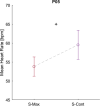Motorless cadence control of standard and low duty cycle-patterned neural stimulation intensity extends muscle-driven cycling output after paralysis
- PMID: 35945575
- PMCID: PMC9360711
- DOI: 10.1186/s12984-022-01064-w
Motorless cadence control of standard and low duty cycle-patterned neural stimulation intensity extends muscle-driven cycling output after paralysis
Abstract
Background: Stimulation-driven exercise is often limited by rapid fatigue of the activated muscles. Selective neural stimulation patterns that decrease activated fiber overlap and/or duty cycle improve cycling exercise duration and intensity. However, unequal outputs from independently activated fiber populations may cause large discrepancies in power production and crank angle velocity among pedal revolutions. Enforcing a constant cadence through feedback control of stimulus levels may address this issue and further improve endurance by targeting a submaximal but higher than steady-state exercise intensity.
Methods: Seven participants with paralysis cycled using standard cadence-controlled stimulation (S-Cont). Four of those participants also cycled with a low duty cycle (carousel) cadence-controlled stimulation scheme (C-Cont). S-Cont and C-Cont patterns were compared with conventional maximal stimulation (S-Max). Outcome measures include total work (W), end power (Pend), power fluctuation (PFI), charge accumulation (Q) and efficiency (η). Physiological measurements of muscle oxygenation (SmO2) and heart rate were also collected with select participants.
Results: At least one cadence-controlled stimulation pattern (S-Cont or C-Cont) improved Pend over S-Max in all participants and increased W in three participants. Both controlled patterns increased Q and η and reduced PFI compared with S-Max and prior open-loop studies. S-Cont stimulation also delayed declines in SmO2 and increased heart rate in one participant compared with S-Max.
Conclusions: Cadence-controlled selective stimulation improves cycling endurance and increases efficiency over conventional stimulation by incorporating fiber groups only as needed to maintain a desired exercise intensity. Closed-loop carousel stimulation also successfully reduces power fluctuations relative to previous open-loop efforts, which will enable neuroprosthesis recipients to better take advantage of duty cycle reducing patterns.
Keywords: Cycling; Exercise; Feedback control; Neural stimulation; Paralysis; Spinal cord injury.
© 2022. The Author(s).
Conflict of interest statement
The authors declare they have no competing interests.
Figures








Similar articles
-
Selective neural stimulation methods improve cycling exercise performance after spinal cord injury: a case series.J Neuroeng Rehabil. 2021 Jul 23;18(1):117. doi: 10.1186/s12984-021-00912-5. J Neuroeng Rehabil. 2021. PMID: 34301286 Free PMC article.
-
The effects of crank power and cadence on muscle fascicle shortening velocity, muscle activation and joint-specific power during cycling.J Exp Biol. 2023 Jul 1;226(13):jeb245600. doi: 10.1242/jeb.245600. Epub 2023 Jul 12. J Exp Biol. 2023. PMID: 37326292 Free PMC article.
-
Effects of differing pedalling speeds on the power-duration relationship of high intensity cycle ergometry.Int J Sports Med. 1996 May;17(4):287-92. doi: 10.1055/s-2007-972848. Int J Sports Med. 1996. PMID: 8814511 Clinical Trial.
-
Physiological differences between cycling and running: lessons from triathletes.Sports Med. 2009;39(3):179-206. doi: 10.2165/00007256-200939030-00002. Sports Med. 2009. PMID: 19290675 Review.
-
Factors affecting cadence choice during submaximal cycling and cadence influence on performance.Int J Sports Physiol Perform. 2009 Mar;4(1):3-17. doi: 10.1123/ijspp.4.1.3. Int J Sports Physiol Perform. 2009. PMID: 19417224 Review.
References
Publication types
MeSH terms
Grants and funding
LinkOut - more resources
Full Text Sources
Medical
Miscellaneous

